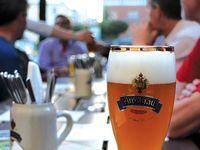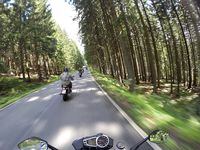Okay, so it's not a bad gig—most of the time. Once again this year, with a lot of help from Edelweiss Bike Travel (edelweissbike.com), we gave seven lucky readers the opportunity to live their motojournalist dreams by joining us on a seven-day comparison test in Europe. Last year's reader tour featured adventure bikes in the Alps; this year we rounded up naked sportbikes and crafted a circuitous route through Germany, Austria, the Czech Republic, and Italy that combined everything from unlimited-speed autobahn to awe-inspiring Alpine passes, with the added bonus of BMW, KTM, and Ducati factory tours. And everyone got a free T-shirt!
Our days were spent inhaling octane and wasting rubber; our nights were spent dining al fresco in Europe’s finest cities, comparing notes about the bikes over countless cold lagers. Just so they didn’t think our work was all wine and wheelies, we demanded our guests give complete test notes on each bike and suffer through some mind-numbing photo/video shoots too. After all, every few dreams you have a nightmare…
Our adventure began in the once-divided city of Berlin, where we gathered from points around the globe and broke the ice with a tour of the historic BMW Motorrad factory at nearby Spandau, where two of the bikes we were testing—the S1000R and RnineT—are brought to life. We were a diverse group: a custom home builder from Canada, a commodity trader from Chicago, an auto-industry insider from Thailand-by-way-of-Detroit, a Dallas doctor, and more. Some had ridden tens of thousands of miles all over the world; for others it was their first time out of the country; one sheepishly admitted, after a particularly soggy stretch of autobahn, that he had never ridden in rain before! Most had some experience on naked bikes, and many owned naked bikes back home. All were passionate about motorcycles, and, just like every Edelweiss tour we’ve done, the group bonded quickly. “Everyone had such a good time,” Tom Bentley said, “laughing like we’ve been friends for 10 years right from the start. It would be a great experience even without the motorcycle riding.”
Click PLAY to watch the Motorcyclist/Edelweiss Tour VIDEO
Following the BMW factory visit, the first day’s ride was an easy, 150-mile warm-up through the Spreewald Biosphere Reserve to Dresden in the former East Germany—for everyone except the author, that is. A scheduling snafu instead sent me 200 miles south to the suburbs of Munich in a rented VW Polo to retrieve our S1000R then 150 miles back to Dresden where I rejoined the group. (That 150 miles was covered in 90 minutes, including a stop for gas—what’s not to love about Germany’s autobahn?)
Day two dawned sunny and bright. After departing Dresden and climbing the rolling foothills of the beautiful Elbe Sandstone Mountains that rise nearly 1,000 feet above Germany’s Elbe River, our guest testers got their first real chance to dive into the act of comparing the bikes—an eye-opening experience for many.
“You guys say it in the magazine all the time: ‘All these bikes are great, it’s so hard to pick a winner…’ And I’m always like, ‘Well, that’s complete malarkey,’” Bentley said. “But it’s true. You could take any of these bikes, and, once you got used to it, you’d love it. But that’s what’s so interesting about riding them back to back. There are differences, and it’s a challenge to figure those out.”
It’s the ultimate bike-geek experience for these guys to compare notes with magazine editors, and it’s priceless for us to learn what regular, cash-paying riders value in a motorcycle too.
“I’ve learned so much just talking with professionals that really know about the industry and these bikes,” Hugo Caballero said. “These guys really know what they’re talking about. Then you try the bike and you say, ‘Okay, they’re right.’ When you switch bikes every two hours, you really get to know these bikes. You start being really critical, and it gets you on another level quick.”
After a short stop at the stunning Bastei overlook in Germany’s Saxon Switzerland National Park, we passed under the rusted-steel awning of a former border checkpoint and crossed into the Czech Republic. Even without the different language on the road signs we recognized immediately that we’d left Germany when the formerly flawless pavement turned choppy and the tiny roadside villages resembled a shabbier, lived-in version of their slightly over-manicured German doppelgängers. Not so the beautiful capital city of Prague, our destination for that night, which fully deserves its UNESCO World Heritage Site designation.
Day three was a beeline toward the Sumava “mountains”—more a collection of steep, rolling hills carpeted with lush green meadows—that bisect the Bohemian and Bavarian forests in the area where Germany, Austria, and the Czech Republic meet. That night was spent in the German city of Passau, a charming, almost-Venetian peninsula where the Inn, Ilz, and Danube rivers meet.
Leaving Passau early the next morning we followed the shoreline of the Inn River to the Austrian town of Mattighofen—the “M” in “KTM”—an otherwise unassuming village of 6,000 except for the massive manufacturing facility on the outskirts of town where the famous orange motorcycles are made. KTM’s factory, a beehive of activity where seemingly hundreds of young workers assembled everything from 65cc minibikes to 1290 Super Dukes side by side, couldn’t be more of a contrast to the unnaturally calm, largely robotized BMW facility we visited in Spandau a few days before. After a light lunch at the factory with our very entertaining tour guide Jochi Sauer—KTM product manager and former European Enduro champion, who was treated like a celebrity on the assembly line—we were off toward our most memorable overnight of the trip in Kaprun, Austria.
No one does fly-and-ride motorcycle touring better than Edelweiss, with more than 30 years experience leading tours in more than 190 countries. One thing Edelweiss excels at is leading you to unique places you’d never find on your own, like our destination for that night, Vötter’s Sportkristall Hotel in the Austrian ski town of Kaprun, with its fabulously bizarre antique automobile (and motorcycle) museum in the basement that’s populated almost exclusively with former East German oddball cars from brands like Opel, Janus, Trabant, Borgward, Messerschmitt, and more. Early the next morning the museum proprietor/hotel owner sent us off with an elaborate torch-lighting ceremony (don’t ask), leaving us with an experience we won’t soon forget.
But we didn’t leave Kaprun without first taking full advantage of another of the biggest benefits of traveling with Edelweiss: the excellent ride guides. There’s never a problem when traveling with an Edelweiss guide, even when there is a problem—like when the Monster 1200S got knocked over in the parking lot, snapping its shift lever off. No problem—five minutes, a 10mm wrench bent into an L-shape, and a few zip-ties later and our guides Frank Bergmann and Harald Pramhofer had us happily back on the road. More impressive was their uncanny ability to modify routes on the fly to avoid ever-present rain and their intuitive understanding of group dynamics, knowing when to add “just one more pass” when the group was especially having fun or to skip that last sightseeing opportunity when we really wanted to just get off the bikes. (Bergmann’s background as a psychiatric nurse—his day job—is probably useful here.)
Bergmann and Pramhofer could really ride, too, as we found out the next day when we finally entered the Alps. Our first Alpine pass was the famous Grossglockner, and not even cold, wet conditions could dampen our enthusiasm for Austria’s tallest mountain—besides, there was warm strudel and marmots to pet in the coffee shop just below the Edelweissspitze summit, where we stopped to warm up. Later that afternoon we hit another highlight, Passo Giau, across the Italian border in the more-dramatic Dolomites. Although Giau isn’t as tall at just 7,335 feet, the weather had dried considerably and we were able to make a proper, footpeg-dragging attack. We truly made the most of this riding day, also tackling Faltarega and Pordoi passes before finally arriving at our ski chalet hotel in the Italian village of Canazei just after dark.
As expected, the high-Alpine riding was remarkable. “I’ve probably done more turns in the last seven days than in all my previous riding experience,” Brooks Trotter said. “And I’ve been riding since 1969!”
“It’s a good thing we were wearing helmets,” Mark Gion added, “or our heads would have exploded all over Europe!”
Day six was literally and figuratively a day of highs and lows. The day started with a spirited climb up Passo Duran, a narrow, mostly deserted paved goat path that was for many of us our favorite pass but was soon derailed by a three-hour delay when one bike took an unplanned detour off the mountainside (the rider walked away). This delay and the requisite rerouting cut our time in the Dolomites short and extended our afternoon stretch on the autostrada (ugh) into Bologna, but it also inadvertently lead to the best meal of the trip. We unexpectedly spent two hours on a veranda behind an off-map, locals-only, no-English-spoken restaurant overlooking the Boldo Valley, gorging ourselves on platter after platter of the most amazing grilled pork, lamb, farm sausages, and vegetables any of us had ever seen. “It looked like I dissected a dinosaur, there were so many bones on my plate,” Bentley said. “What a meal!” On an Edelweiss adventure, nothing ever goes “wrong.”
Our final destination, Bologna, was the only city where we spent two nights—and we needed the extra time to take in all the sights. Bologna is nicknamed “The Red City” ostensibly for its abundance of terracotta buildings and its traditionally left-wing politics, but we motorcyclists know it’s because the city is home to Ducati, located in the Borgo Panigale neighborhood. We started our day with a tour of the Ducati factory, watching Panigale superbikes and Diavel mega-cruisers being built largely still by hand in the same building where the company made radios in the 1920s and motorized bicycles beginning in 1945. After the assembly line we spent some time in Ducati’s amazing on-site museum that holds more than 50 championship-winning racebikes ridden by heroes like Hailwood, Smart, Fogarty, Bayliss, Hayden, and Stoner. Everyone but Valentino Rossi, curiously…
Looking at great motorcycles is one thing, but riding them is something else—which is why we rushed out of the museum before lunch and suited up for one last ride, aiming toward Passo della Futa in the Appennine Mountains just beyond Bologna, the very same roads where test riders develop Ducati’s legendary sportbikes. This was the last ride of the tour, and we made the most of it, “riding like escaped convicts,” Bentley said. If you haven’t before, it’s hard to overstate just how thrilling it is to ride a motorcycle in a country like Italy, where cars move aside when you approach, where double-yellow passes are no big deal, and where speed limits, at least when you’re not passing through a town, are advisory at best. It’s something every rider should experience at least once, and doing it with Edelweiss makes it a breeze. Gion has ridden Europe independently too but prefers riding like this: “[They] take care of the details. You know where you’re going to stay; you know you’ll get fed. You can turn your brain off and focus on the ride instead.”
Once again, our reader tour was a huge success. “For me, this was the best riding trip ever,” Caballero said. “‘Awesome’ is such a cliché word. Is ‘orgasmic’ too much? It was more than I expected, really. If you call me, I will be here every year without thinking twice.” We had so much fun, in fact, that Bentley and Gion were already laying the groundwork for a stateside “No Schnitzel” reunion tour next summer in the US—sign us up for that!


























/cloudfront-us-east-1.images.arcpublishing.com/octane/QSTCM6AVEZA5JJBUXNIQ3DSOF4.jpg)
/cloudfront-us-east-1.images.arcpublishing.com/octane/U4I7G625B5DMLF2DVIJDFZVV6M.jpg)
/cloudfront-us-east-1.images.arcpublishing.com/octane/B6XD6LS6IVCQPIU6HXDJSM3FHY.jpg)
/cloudfront-us-east-1.images.arcpublishing.com/octane/ICL63FEDDRDTTMINYICCEYGMDA.jpg)
/cloudfront-us-east-1.images.arcpublishing.com/octane/FCGZHQXRBZFLBAPC5SDIQLVF4I.jpg)
/cloudfront-us-east-1.images.arcpublishing.com/octane/WNOB6LDOIFFHJKPSVIWDYUGOPM.jpg)

/cloudfront-us-east-1.images.arcpublishing.com/octane/X33NU3E525ECRHXLNUJN2FTRKI.jpg)
/cloudfront-us-east-1.images.arcpublishing.com/octane/6KKT5NNL2JAVBOXMZYS5ZO76YA.jpg)
/cloudfront-us-east-1.images.arcpublishing.com/octane/J5RKG5O455GMPGQRF2OG6LRT7A.jpg)
/cloudfront-us-east-1.images.arcpublishing.com/octane/GX2CIZKQVRH2TATDM26KFG2DAE.jpg)
/cloudfront-us-east-1.images.arcpublishing.com/octane/ZWIDYSAKQZHD5BHREMQILXJCGM.jpg)
/cloudfront-us-east-1.images.arcpublishing.com/octane/CYUHJZCTSJCH3MRAQEIKXK7SCQ.jpg)
/cloudfront-us-east-1.images.arcpublishing.com/octane/LKOFINY56FCXJCANJ5M7ZDQUBY.jpg)
/cloudfront-us-east-1.images.arcpublishing.com/octane/4NBPDACMWJH63JQYJVK3QRBDZI.jpg)
/cloudfront-us-east-1.images.arcpublishing.com/octane/KKHQHRR3FJGX7H2IPU6RALMWG4.jpg)

/cloudfront-us-east-1.images.arcpublishing.com/octane/5IOFS5JAE5FOXMNA23ZRAVVYUU.jpg)
/cloudfront-us-east-1.images.arcpublishing.com/octane/CGXQ3O2VVJF7PGTYR3QICTLDLM.jpg)

/cloudfront-us-east-1.images.arcpublishing.com/octane/OQVCJOABCFC5NBEF2KIGRCV3XA.jpg)
/cloudfront-us-east-1.images.arcpublishing.com/octane/OPVQ7R4EFNCLRDPSQT4FBZCS2A.jpg)
/cloudfront-us-east-1.images.arcpublishing.com/octane/YBPFZBTAS5FJJBKOWC57QGEFDM.jpg)
/cloudfront-us-east-1.images.arcpublishing.com/octane/W5DVCJVUQVHZTN2DNYLI2UYW5U.jpg)